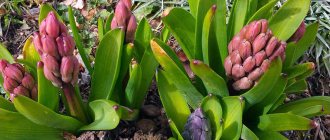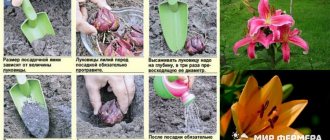In early spring, when the snow has not yet melted in dachas and gardens, low primroses appear. Scientifically, these plants are called saffron. But in floriculture they are better known as crocuses. India is considered the birthplace of saffron; it later spread to most of Europe and Asia.
First spring crocuses
This plant was known back in Ancient Egypt and Greece. Homer and Hippocrates wrote about saffron. The flower was used as an expensive medicine and dye. Crocus stigmas contain a yellow substance that gives a yellow tint to butter, cheeses, and soft drinks. No wonder the word “saffron” has Arabic roots and is translated as “yellow”. Introduced to Europe, the flower found its place in the heraldry of the House of Bourbon, and in Foggy Albion the city was even named after this plant - Saffron. Saffron is also the most expensive spice in the world.
Crocuses: flower features
Crocuses belong to the saffron genus and are part of the large Iris or Kasatikov family. Scientists have described eight dozen species and three hundred varieties of crocuses. A number of them were included in the Red Book. Like numerous relatives, saffron is a corm plant that can delight its owners with bright flowering for many years.
Crocus bud
Saffron corms usually have a flattened or round shape with a diameter of 3 cm. The stem of the flower is undeveloped, and narrow leaves grow directly from the root. Each plant produces a single flower, sometimes 2–3 buds appear. The flowers are goblet-shaped and reach 2–5 cm in diameter. There are two large groups based on color: yellow-flowered with various shades and blue-flowered. The latter have shades ranging from pale and almost white to dark purple. There are albino species and bicolor varieties; spotted buds are less common. Crocuses bloom from 15 to 20 days . Plant height ranges from 8 to 10 cm.
After flowering, fruits appear in place of the bud - boxes in which small, angular seeds ripen.
How to plant crocuses correctly
The agricultural technology for planting an onion and a crocus from a pot is slightly different, but in any case it is better to prepare the soil in the fall so that it settles and becomes structured. The area allocated for flowers is dug up, plant remains and roots are removed, fertilizers are applied, and in the spring they are only loosened.
Since crocuses are family plants, they are planted in a clearing (clump) so that when they bloom they look as decorative as possible.
It is advisable to plant tubers of the same size together - then there will be no bald spots between them.
Bulb planting rules:
- dig a hole twice the height of the bulb (≈ 5-6 cm);
- interval between holes - 5 cm;
- pour sand (1 cm) onto the bottom;
- place the onion without pressing the bottom into the sand;
- fill the voids, lightly pressing the soil, water;
- After the water has been absorbed, add soil and water a little more;
- mulch with humus (2-3 cm).
On a note! If the bulb is deeply buried or the soil is heavy, the sprouts may not break through the soil.
Video: How to plant crocuses in the ground from a pot
The soil for transplanting a flower from a pot to a garden bed is prepared in the same way. If the flower has peduncles, they are cut off and the leaves are left. If it is necessary to divide a plant, then it is divided and each division is planted separately. A hole is dug a little larger than the size of a clod of earth. Then proceed as described above.
Related article:
TOP 5 important things to do with flowers in the fall or what you need to do in the flower garden before the cold weather
Features of cultivation
Crocus flowerbed
Crocuses are unpretentious in cultivation and care, they reproduce easily, which is why they are popular even among novice gardeners. Plants are used in the garden for decorative design of alpine slides and flower beds; saffron also looks good in regular group plantings next to other perennials. The spring flowering period of saffron is somewhat limited; the buds bloom while the snow is melting. But today there are also hybrid varieties that bloom until the end of May. There are also species that decorate gardens in autumn.
Growing spring and autumn varieties differs only in the time of planting crocuses in open ground, the dates of fertilization and digging. In everything else: care, watering, soil requirements - everything is done the same.
Spring-blooming crocuses begin their annual cycle with the last weeks of winter and the beginning of spring. Their first shoots appear. The dormant period occurs from mid-June to autumn. This stage is just right for digging up and transplanting bulbs. Crocuses that continue to grow begin to awaken and actively accumulate nutrients in the fall.
Fall-blooming crocuses begin their annual cycle in August. The plant first produces a peduncle, and only then leaves appear. At this time, the formation of the bulb occurs. The dormant period for these types of saffron begins somewhat earlier than for other flowers. If necessary, corms of autumn-blooming crocuses are dug up and replanted almost all summer.
Popular varieties of crocuses
Crocus differs in terms of flowering:
- Early spring (February-April). As a rule, it is golden-flowered, or golden (Crocus Chrysanthus);
- Spring blooming (April-May). Spring (Crocus vernus);
- Autumn blooming (late September - early December).
Lovely (Crocus speciosus)
The most popular autumn varieties of crocuses are:
- Lovely (Crocus speciosus);
- Pale ocher (Crocus Ochroleucus);
- Holoflorus (Crocus Nudiflorus);
- Long-flowered (Crocus Longiflorus);
- Smoothed (Crocus laeviatus);
- Saffron (Crocus Sativus) is the most elite and healthy.
Important! The most famous and widespread are spring crocuses, so what follows will be about planting and growing them.
Selecting a site for planting
Flowers need a spacious garden plot where they will have plenty of room to grow. The site for planting crocuses in open ground is selected taking into account good lighting. Sites near trees and bushes are also suitable, because the appearance of foliage is still a long way off. You should not plant flowers in places where there is constant shadow. Here the crocuses will be uncomfortable, they will develop poorly and bloom little. To accompany the flowers, choose short and medium-sized perennials: hostas, peonies, ivy and others.
Crocuses prefer sunny places in the garden
The planting site should not be in a lowland; crocuses are not suitable for places with stagnant melt or rainwater. Flowers grow well in fertile soils with good drainage. Light loams are perfect. If the soil on the site is heavy, adding sand, compost, and fine gravel will help improve its quality. Lime is added to acidic soil. It is advisable to fertilize soils that have lost fertility in advance. Compost or humus is placed in the planting holes.
Planting crocuses in spring and autumn
Crocus bulbs
Depending on the variety and type of saffron, flowers are planted in open ground at different times. Indeed, in addition to crocuses that bloom in early spring, specimens that produce buds in the fall are also grown on plots.
Approximate dates for planting crocuses:
- From the beginning of summer until almost August - for autumn bloomers . Flowering will occur in September - October.
- From mid-August to early October - for spring bloomers . Buds appear already in March and April.
If you purchased a plant with an open bud, the flower must be cut off when planting. Otherwise, the crocus will have little chance. If such a plant takes root, it will slow down in growth and will be able to bloom only after a year. But it will come into full force only after 2 years. With this development of events, the leaves and flowers of the crocus are removed, and the flower itself is left alone. Therefore, in order for plants to please with flowering in the same year, saffron is purchased in bulbs.
Tips for choosing quality crocus bulbs
In order for crocuses to decorate your garden in early spring, you must choose the highest quality plant bulbs, and before purchasing you should carefully inspect them:
- it should not show any signs of disease: mechanical damage, rot, stains and sores;
- the bulb must be healthy: dense and well dressed, that is, covered with dry scales;
- there should be no overgrown roots or stems on the bulb;
- It is better to choose the largest onions.
Preparing and planting corms
Processing bulbs in potassium permanganate
To get a healthy plant, in addition to proper care, you need to choose good planting material. Crocuses are planted with corms. When purchasing them in stores or on the market, you should pay attention to their appearance.
You should refuse to purchase if the bulbs have the following signs:
- rotten areas;
- dark spots;
- mechanical damage.
If, after all, there are damaged specimens in the planting material, then they need to be sorted out. Obviously rotten ones should be thrown away, and small wounds on the bulbs can be treated with ash.
Before planting in open ground, corms are soaked in a special product to prevent various diseases. There are now many such preparations; they are purchased in stores for gardeners and summer residents. The simplest thing is to keep the planting material in a solution of potassium permanganate.
Autumn planting of crocus bulbs
Plant the bulbs to a depth of 6-10 cm with the bottom down. A distance of up to 10 cm is left between plants. It is not recommended to plant flowers closer; in a few years entire families of crocuses appear on the plot. The bulbs are sprinkled with earth on top and watered.
Planting crocuses under the lawn
There is another way to plant. If you want to get neat flowers on the lawn, then you need to open the turf like a book leaf, loosen the soil and root the bulbs. Then the ground is watered and the lawn layer is put in place.
Preparation of planting material
The correct choice of planting material, along with the choice of location and proper planting, is the key to successful growth. The bulbs must be of high quality and healthy.
Related article:
Double sunflower
What to pay attention to:
- information about flowering times and varietal characteristics;
- appearance - free of damage, stains, dents, signs of infection and insects;
- pulp - dense, elastic;
- scales are dry, tightly adjacent to the head;
- bottom - without roots, rot;
- size - large bulbs are preferred.
Before planting, the corms must be treated to destroy possible pathogens and prevent their occurrence in the future. To do this, they are soaked for half an hour in a pink solution of potassium permanganate or in a fungicide (2 ml/1 l). Growth stimulants can be used. Favorable times for landing are early morning, evening before sunset, cloudy day.
If you cannot plant sprouted bulbs in the fall, then planting them in the spring is permissible. You need to carefully place them in the hole so as not to damage the roots.
Crocus care
Saffron thrives in the wild. Therefore, complex care for crocuses in open ground is not required.
A distinctive feature of saffron is its ability to survive in dry weather. But in this case, the height of the flowers will be slightly smaller.
Crocuses prefer loose soil
In order for crocuses to develop and bloom well, the following rules should be followed:
- Plants practically do not need watering. They bloom in early spring, when the ground is still saturated with moisture from melted snow. Additional watering is required only in case of little snow winter. But even without receiving moisture, the flowers still continue to develop, but grow smaller.
- Although wild saffron is a drought-tolerant plant, it requires regular watering in the garden. Lack of moisture during the period of active growth will affect the size of the bulbs and subsequent flowering.
- Care must include loosening the growing area and weeding.
- Leaves are removed from the plant only when they are completely dry.
- After the ground part of the crocuses dies, the soil can be mulched if desired. For this, compost, peat, and sawdust are used.
- After 3–4 years, crocuses are planted due to the appearance of children. This is done during the summer.
Feed flowers during intensive growth. The plant especially needs phosphorus and potassium. And nitrogen-containing fertilizers should be handled carefully, as large quantities can provoke the appearance of fungal diseases. Fertilizing in the form of a complex fertilizer is applied twice a season: in the spring while there is still snow (up to 40 g per square meter) and during the period of budding and flowering.
Crocuses in landscape design, combination with other plants
Saffron has found great use in creating beautiful landscapes in summer cottages - in a flowerbed, in a mixborder, in a garden bed, as a flower carpet or in small groups. For this purpose, primroses with a variety of colors are used.
Crocuses go well with other bulbous plants such as tulip, daffodil, and hyacinth. With this combination, you get an irreplaceable spring landscape that will decorate any garden.
Crocuses look expressive on alpine hills and rock gardens. Bright colors set off the gray appearance of rocky structures. After flowering has ended, ground cover or low-growing annuals are planted in place of the saffron.
In flower gardens, saffron is combined with low-growing shrubs. The varied colors of crocuses harmonize well with low-growing conifers and evergreens. Dutch, large-flowering varieties make beautiful patterns on lawns.
When planting on lawns, you need to be extremely careful when mowing the lawn, since the green leaves provide the bulb with all the necessary nutrients for further flowering. Autumn flowering species are planted in shady corners of the garden, since the plant does not bloom well in bright sun.
Transfer
Transplanting crocus bulbs
Unlike its close relatives, whose bulbs must be dug up for storage, crocus is not so scrupulous in matters of wintering. The plant tolerates cold well in open ground. But it is still advisable to dig up corms once every few years, at least to plant them. Several babies (from 1 to 10 pieces) are constantly growing on the mother's bulb. Crowding during development leads to a decrease in flower size. To obtain large planting material, bulbs are dug more often.
The corms removed from the soil are sorted and sorted, and checked for diseases. They are then sent for drying and storage or replanted. Crocuses are transplanted during the summer dormancy period. Thus, planting of spring-blooming specimens is carried out no later than the end of September, and autumn-blooming specimens - until mid-August.
It must be remembered that crocuses can also reproduce by self-sowing. And if you don’t take care of the plant, after a few years the owner of the site runs the risk of getting not a cultivated plant, but an annoying weed that grows anywhere.
The most common types of crocuses with descriptions and photos
As we already said earlier, about 80 species and 300 varieties of crocuses are known. Of course, we won’t be able to introduce you to all of them, but we can easily introduce you to the most amazing, most beautiful and most unique of them.
Guseva Ulyana
Ask a Question
Question to the expert
Tell me, what type of crocus will take root best in the regions of Eastern Russia?
Of those blooming in spring - two-flowered and golden, of those blooming in autumn - Banat and all hybrids.
To make it easier for you to navigate, we have distributed our selection in such a way as to divide all crocuses into those that bloom in spring and those that bloom in autumn.
Reproduction
You can get new plants in two ways: propagation by daughter bulbs and seeds.
Crocus bulbs with “babies”
The first method is simple. Several babies are formed on the mother's bulb. To plant crocuses over a larger area, the bulbs are dug up after 3–4 years. The children are separated from the mother’s body and rooted in new places as during the initial planting. Such a small bulb will bloom after 3-4 years. It is worth noting that vegetative propagation when planting crocuses in open ground allows you to maintain the purity of the variety.
Crocus seeds
The seed propagation method is rarely used, since such plants bloom only after 4–5 years. Typically, spring-flowering saffron is used for this. In flowers that open buds in the fall, the seeds do not have time to ripen.
Possible problems and their solutions
Often gardeners are faced with a lack of flowers from planted crocuses. This is possible for several reasons:
- Incorrectly selected varieties. Crocuses come in spring and autumn blooming. The first ones need to be planted in the fall, and the second ones in the spring. Confusion with planting dates leads to plants not blooming.
- Pests. Crocus bulbs are a favorite treat for rodents. Damaged tubers, unfortunately, do not allow the plant to bloom.
- Excessive division. In cases where the mother bulb produces many children, it does not have the strength to flower.
- Errors during landing. Strong deepening of tubers, abundant watering, planting damaged or diseased bulbs - all this is the reason for the lack of flowering.
Diseases and pests
Crocuses do not get sick very often, but they can contract a viral or fungal disease, which leads to wilting and in some cases death.
In case of viral diseases, the buds of the flower become deformed and gray spots appear on the petals. The damaged plant should be removed from the site as quickly as possible and destroyed so as not to infect neighboring individuals. When caring for crocuses in the open ground and for the prevention of diseases, they are treated against insect pests, which carry viruses.
Fungal diseases lead to rotting of plants. First, the bulb is affected, it becomes soft and wrinkled. The emerging sprout also becomes sick. The diseased plant is destroyed. Fungal diseases include chlorosis, fusarium, gray and sclerotial penicillium rot . To prevent them, corms are carefully checked before planting for damaged areas. It is also customary to treat seed material with various preparations containing copper.
Crocus pests
Crocuses are harmed not only by insects, but also by rodents: mice and moles. Turntables and special devices with ultrasound help to get rid of the latter. Insect pests (caterpillars, slugs) have to be picked off by hand and destroyed. Plants are also treated with insecticides. This must be done because of the possible threat of viral diseases.
After flowering
Withered crocuses
When caring for crocuses in the open ground, the wilted buds are cut off. But you can leave the foliage, let it decorate the garden with its greenery. Later it will wither on its own. In winter, the area with crocuses can be covered with mulch. To do this, use peat or dry leaves.
If spring-flowering bulbs are intended for digging, then they are removed from the soil in the summer after the leaves have withered. The planting material is dug up, dried, and earthen lumps and dead particles are removed. For storage, place in boxes in one layer. The temperature in a dark, dry room should not exceed 22 °C.
origin of name
Why crocus? This name comes from the Greek word, which means “thread”, “fiber”, but the word “saffron” is Arabic and translates as “yellow”. Please note that the stigmas of the flower have exactly this shade. Quite often crocuses are mentioned in Egyptian papyri. At that time, many doctors and philosophers wrote about the plant. Modern connoisseurs love the crocus because it is one of the very first spring flowers. But it is worth paying attention to the fact that some crocuses (saffron) bloom in the autumn.











